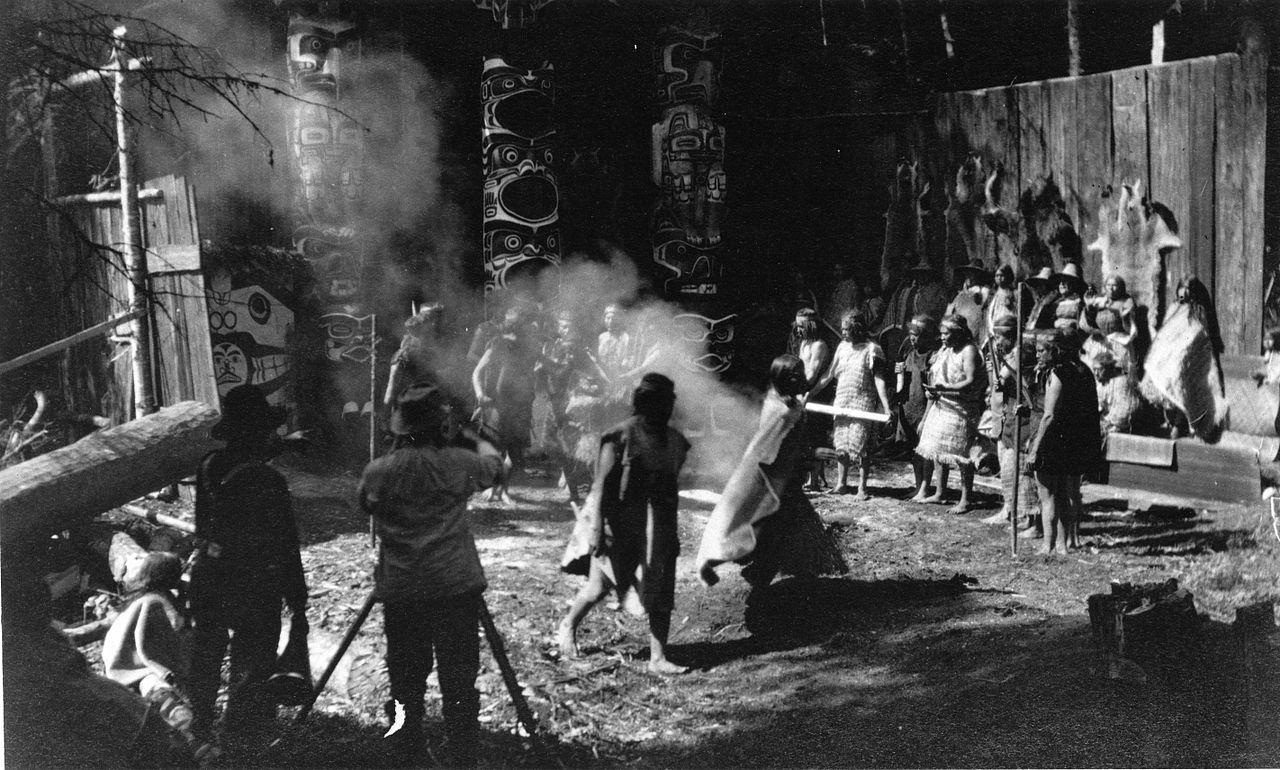
A scene from the filming of In The Land of The Head Hunters. Photo from Universituy of Washington Press
Edward S. Curtis is well known for his photos of Indian life at the turn of the century but he also produced a short film, In the Land of the Head Hunters with Native actors from British Columbia. Mohawk artist and poet Alex Jacobs offers a review:
We are comfortable in the 21st century and distanced from the nuances of our own cultures and knowing practically nothing of other Native cultures in these images, yet give arm-chair critiques of what “we now think is real”, just as Curtis was attempting to do 100 years ago. Think about that, what was happening to our ancestors 100 years ago? From a population low of 250,000 to the current estimate of 5.2 million, we are not the Vanishing People that Edward Curtis and the rest of the United States thought would be our inevitable destiny. The political correctness of our own people now decries every image, book, film or discussion that offends our modern sensibilities. But the Kwakwaka’wakw were there at every step to help bring this film back because their relatives were in it and it was their community and it is actually a piece of modern history that could reach back even further. Native and non-Native critics will continue to debate the merits of “everything Curtis” and there will always be disclaimers attached to his work to remind people that what they are seeing is not quite exact yet, there is truth to be revealed. But Native people, elders and scholars should be the ones recounting the memories, stories and knowledge that the film and photos evoke. “In The Land of the Head Hunters” is an amazing document of a film, but it is not a documentary, yet people believed it to be so. The Kwakiutl partnered with Curtis to make a “modern” film by recreating the settings and cultural lifestyles that the governments wanted abandoned. The spectacle about head hunting was for effect, supposedly taken from oral tradition, the Natives say it was fabricated. Boaz and other ethnographers refer of practices attributed to a Kwakiutl tribe, the Lewiltok, who raided up and down the Pacific Coast. The love story is archetypal from any number of ancient cultures. The film was “Hollywood-ized” as we would term it today, just as the film industry was beginning, so they could to promote the spectacle.Get the Story:
Alex Jacobs: In the Land of the Head Hunters (Indian Country Today 12/12)
Related Stories
Photos: Edward Curtis documented Indian life at
turn of century (12/9) Travel: Tracing the path of Edward Curtis through Indian Country (06/05)
Kevin Abourezk: Interest still strong in Edward Curtis photos (02/18)
Peter d'Errico: Indigenous people outlast Edward Curtis photos (12/04)
PBS: Book offers portraits of Native lives though Edward Curtis (11/23)
Review: Edward Curtis documented 'vanishing race' of Indians (11/12)
Review: A glowing portrait of Edward Curtis and his 'Epic Life' (10/30)
Review: Book tackles 'Epic Life' of photographer Edward Curtis (10/15)
Blog: Edward Curtis captured humanity of the first Americans (10/12)
Smithsonian: Edward Curtis and epic Indian Country photos (03/21)
Colorlines: 'Smiling Indians' is a highly moving meditation (04/26)
'Smiling Indians' video a response to historic Ed Curtis photos (03/23)
Join the Conversation
